DI boxes (Direct Injection Boxes, also known as Direct Input Boxes) are primarily used to convert high-impedance, unbalanced instrument signals (such as those from electric guitars, basses, keyboards, etc.) into low-impedance, balanced audio signals (like XLR interface microphone level signals), ensuring compatibility with professional audio equipment. Their core function is to resolve signal matching issues between instruments and professional audio devices, enhancing sound quality and reducing noise. They are indispensable tools in live performances and recording studios. The main uses and advantages are as follows:
1、Signal Conversion and Impedance Matching
High to Low Impedance Conversion: The output signals from instruments (such as electric guitars, basses) are typically high-impedance unbalanced signals (e.g., 6.35mm TS interface), while professional equipment like mixers and recording interfaces require low-impedance balanced signals (e.g., XLR interface). DI boxes serve as a bridge to prevent signal loss and high-frequency roll-off.
Balanced Output: After converting to balanced signals (XLR), it allows for long-distance transmission (e.g., from stage to control room) without being easily susceptible to noise interference.
2、Eliminate Ground Loop Noise
Isolation Function: The Ground Lift switch on the DI box can disconnect the ground loop between devices, eliminating AC noise at 50/60Hz caused by multiple device grounds.
3、Compatible with Different Devices
Connect to Mixers/Recording Interfaces: Directly connect instruments to the microphone input channels of mixers, avoiding the use of mismatched high-impedance line inputs.
Stage and Studio Applications: During performances, basses/keyboards can send a signal to the PA system via a DI box; in recording, ensure a clean direct signal.
4、Signal Distribution
Parallel Output (Thru/Parallel Out): Some DI boxes offer a parallel output, allowing the original signal to be simultaneously sent to the stage amplifier while another signal is routed to the mixer, balancing on-stage monitoring and mixing needs.
5、Equipment Protection
Prevent Level Mismatch: Avoid damaging the sensitive preamp circuits of mixers with high-level signals from instruments.
Reduce Interference: Balanced signals have strong anti-interference capabilities, making them suitable for complex electromagnetic environments (e.g., near stage lighting, wireless devices).
Common Use Cases and Categories:
Electro-Acoustic Instruments (basses, electric guitars, synthesizers, electronic drums, etc.);
Acoustic Instruments (acoustic guitars, violins, etc., with pickups installed);
Long-Distance Transmission (concert halls, theaters, and other venues requiring signal transmission over long distances).
DI boxes are divided into active and passive types. An active DI box, also known as an active direct injection box, requires phantom power or battery power. It is suitable for instruments with low output levels (such as keyboards) and provides cleaner signal amplification. A passive DI box, also known as a passive direct injection box, does not require power. It is suitable for instruments with high output levels (such as basses), offering natural tone but potentially rolling off high frequencies.
At the 2025 NAMM Show in the United States, IK Multimedia launched two professional DI boxes: the passive DI300-P and the active DI600-A. The passive DI300-P is an instrument pass-through box that delivers rich, natural tone. The active DI600-A (which supports switching between active and passive modes) provides a warm, vintage analog sound.
The core technology of the DI300-P and DI600-A is their built-in, self-developed transformers. In addition to converting high-impedance instrument signals into low-impedance line signals, they offer excellent technical performance, such as a wide frequency response of 10Hz to 40kHz, ensuring clear dry signals without coloration, a 20dB attenuation button to reduce sound distortion, and ground lift switching to isolate ground noise.
Equipment Appearance, Build Quality, and Extensibility
The DI300-P and DI600-A come in simple packaging, with anti-counterfeit labels on the side of the box.

The packaging includes a hard storage case, which is standard and also serves as the product's internal packaging. The quality of the case is excellent, with the IK Multimedia logo in English on the front of the box.

The DI box and product documentation are included inside the storage case, as shown in the following figure.
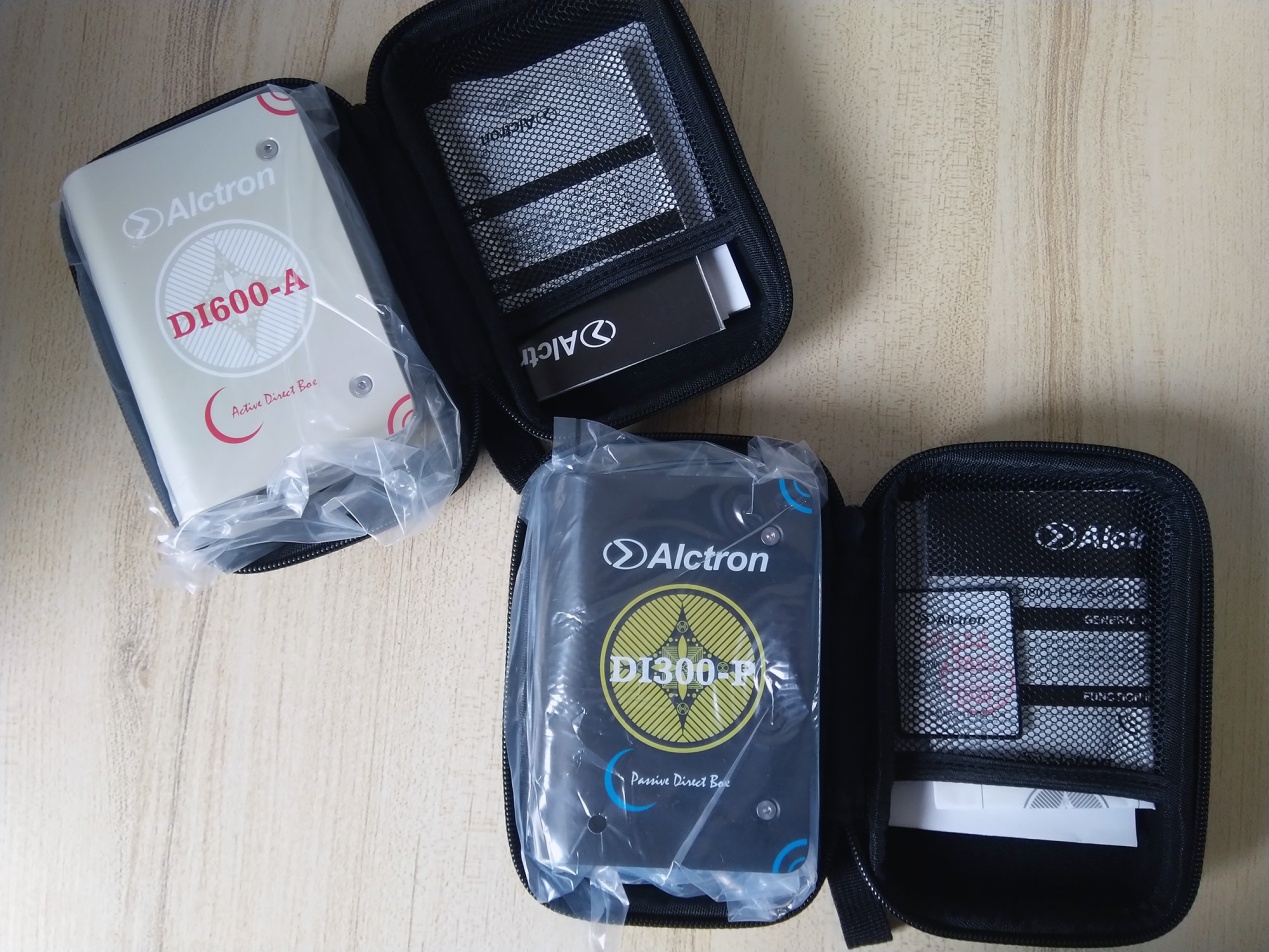
The documentation includes a bilingual user manual in Chinese and English, a product warranty card, and a certificate of conformity.
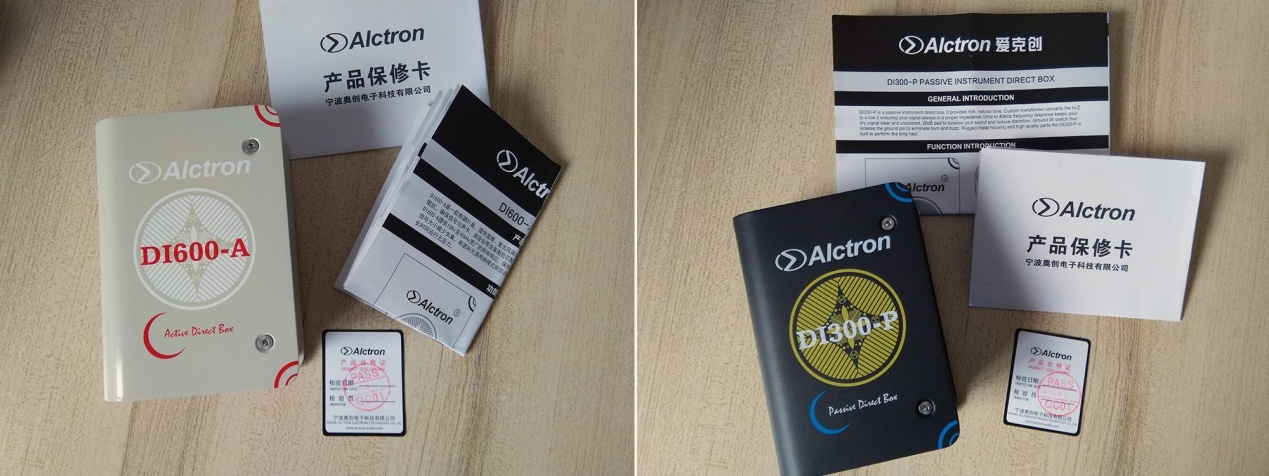
The DI300-P and DI600-A feature a design reminiscent of guitar effect pedals (see below), visually coordinating with single or combo effect pedals. Their all-metal chassis is robust and reliable, ensuring durability in both studio and stage environments without damage from knocks or bumps.
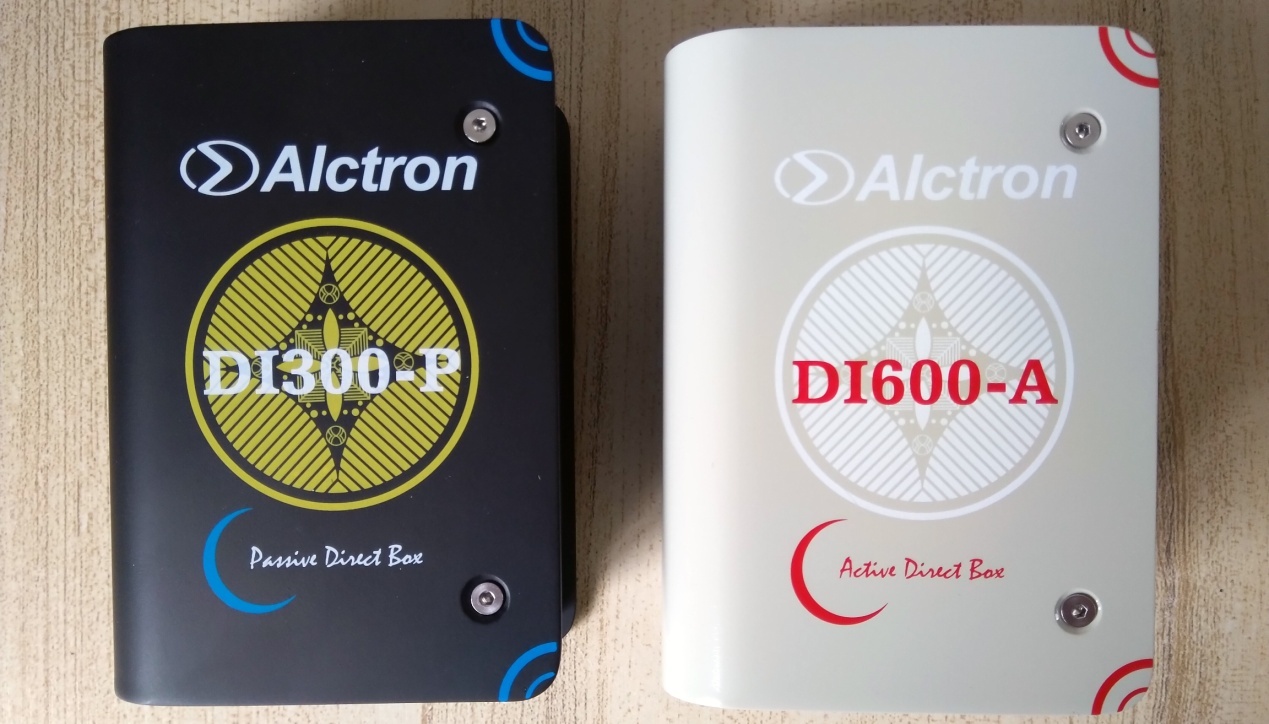
Both models share the same chassis construction. The following images showcase close-up views from different angles.
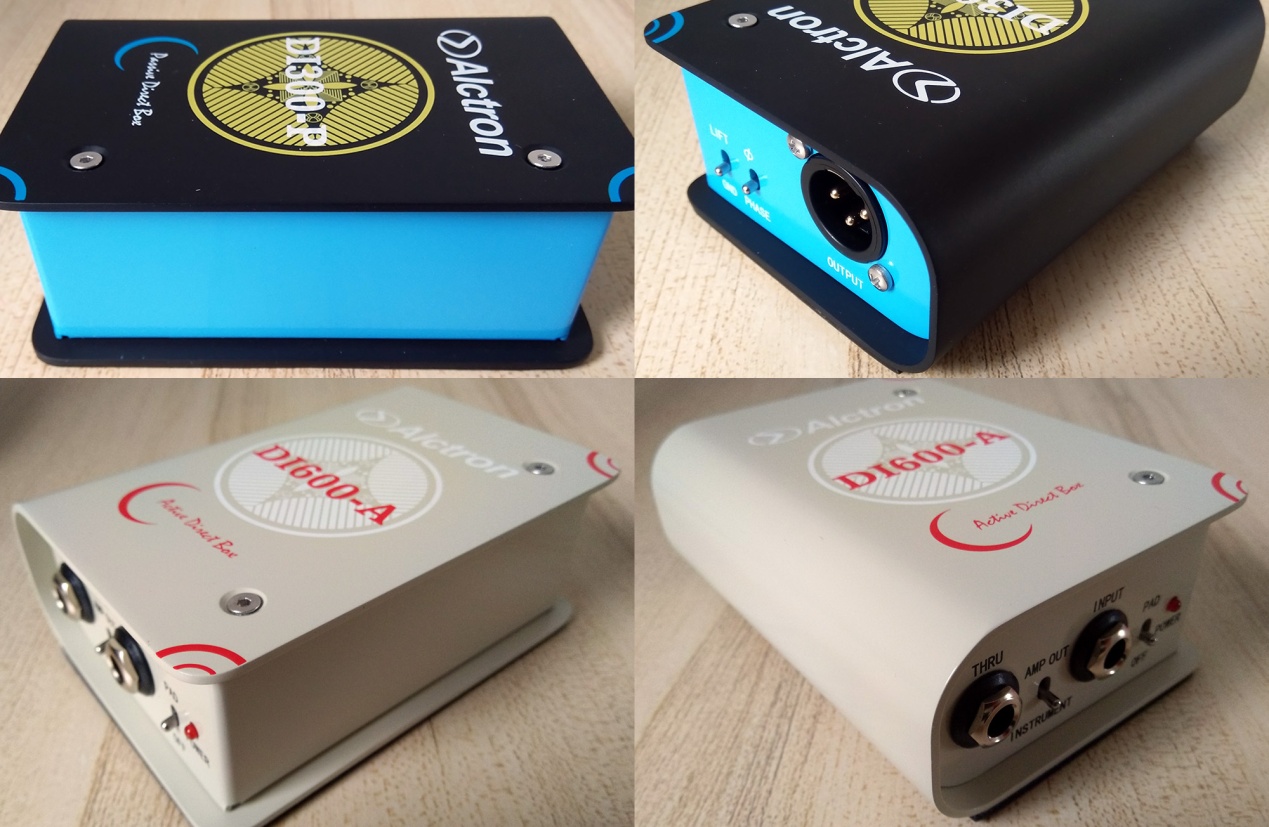
The bottom of the chassis is lined with a layer of EVA polymer foam material, providing a certain level of protection. This material offers excellent flexibility and elasticity, remaining soft even in low temperatures, as well as superior impact resistance and wear resistance.
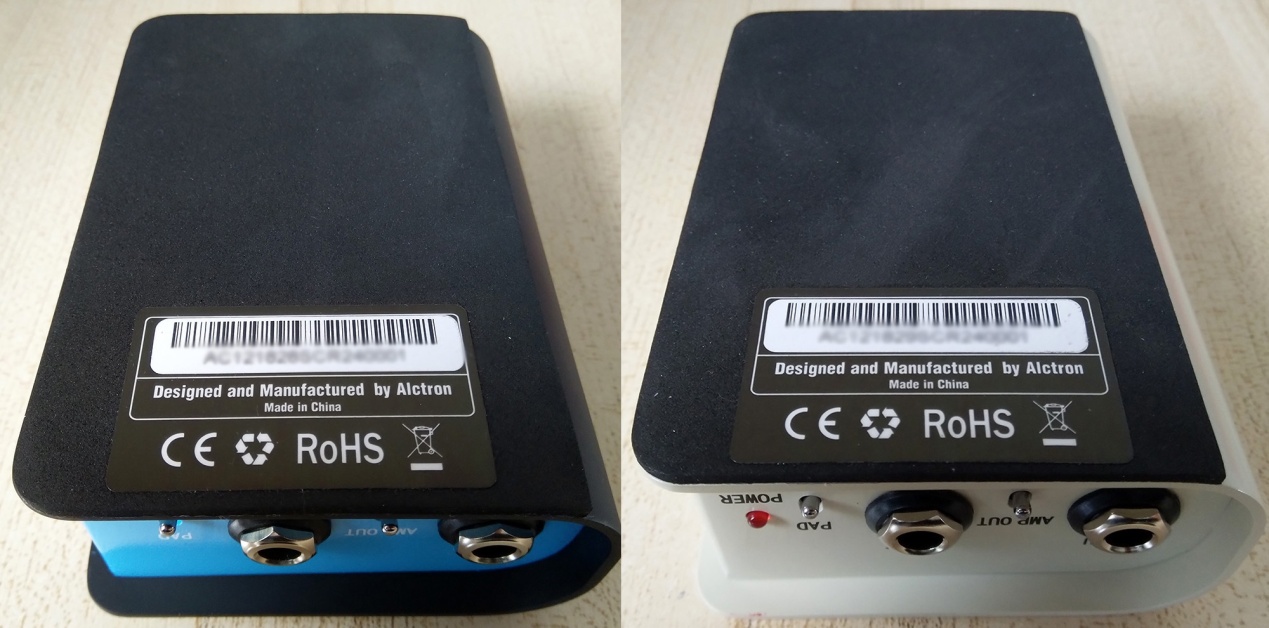
The interfaces and control functions are concentrated at the front and rear ends of the DI box. Due to functional differences, the DI300-P and DI600-A have slightly different control capabilities. The following image shows a comparison of the interfaces and control functions of the two DI boxes.
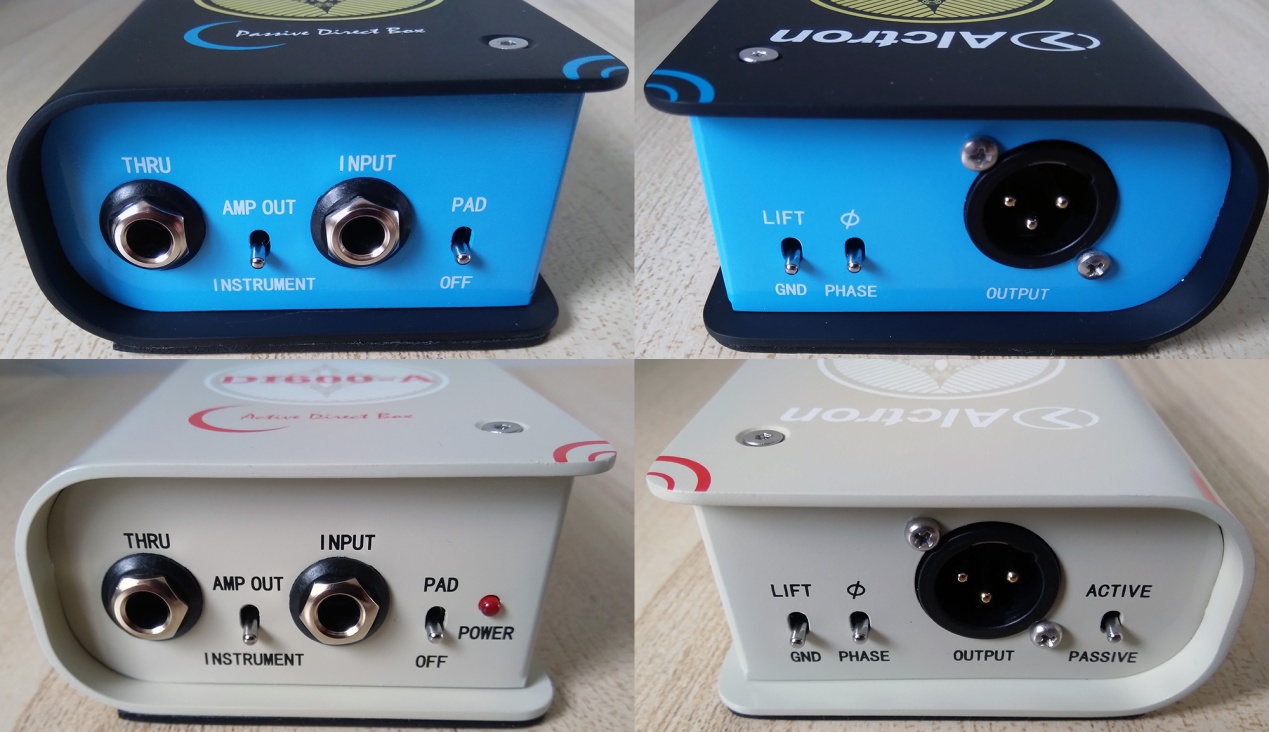
As can be seen, the basic functions of both are consistent. As an active DI box, the DI600-A requires a 48V phantom power supply through the OUTPUT interface to operate. When powered, the red POWER indicator light will illuminate, signaling that it is in working mode. Additionally, the DI600-A can switch between active and passive modes, meaning it can function as either an active or passive DI box. This flexibility makes it more versatile in practical use and enhances its signal processing capabilities. Its advantage lies in its ability to reduce noise while minimizing impedance when dealing with weak passive instrument signals. The signal is buffered and balanced, ensuring natural, full sound even at low output levels. The ACTIVE/PASSIVE switch allows for seamless switching between active and passive modes during use.
The DI300-P, on the other hand, is a passive DI box that does not require external power. Simply put, its purpose is to "pass through" the input signal internally. Compared to the DI600-A, it is less powerful and flexible in terms of signal processing. Of course, both DI boxes have their specific applications. For high-output instruments (passive basses/guitars), the affordable DI300-P is the preferred choice. For low-output instruments (keyboards/active pickups), the DI600-A offers a more optimized solution.
技术参数与性能
参数 | DI300-P | DI600-A |
音频线路 | 无源,有变压器 | 有变压器 |
频响 | 10Hz-40kHz | 10Hz-40kHz |
THD | 0.002%@1KHz | 0.002%@1KHz |
输入阻抗 | 1M Ohms | 1M Ohms |
平衡输出阻抗 | 600 Ohms | 600 Ohms |
衰减 | 20dB | 20dB |
电源 | 无 | 48V幻象电源 |
From the official technical specifications in the table above, it can be seen that the DI300-P and DI600-A share the same performance parameters. However, the transformer plays a significant role in determining the DI box's performance. Due to functional differences, their circuits also vary. The passive DI box uses a transformer for coupling, while the active DI box employs an active op amp/FET circuit. See the following disassembly images for details.
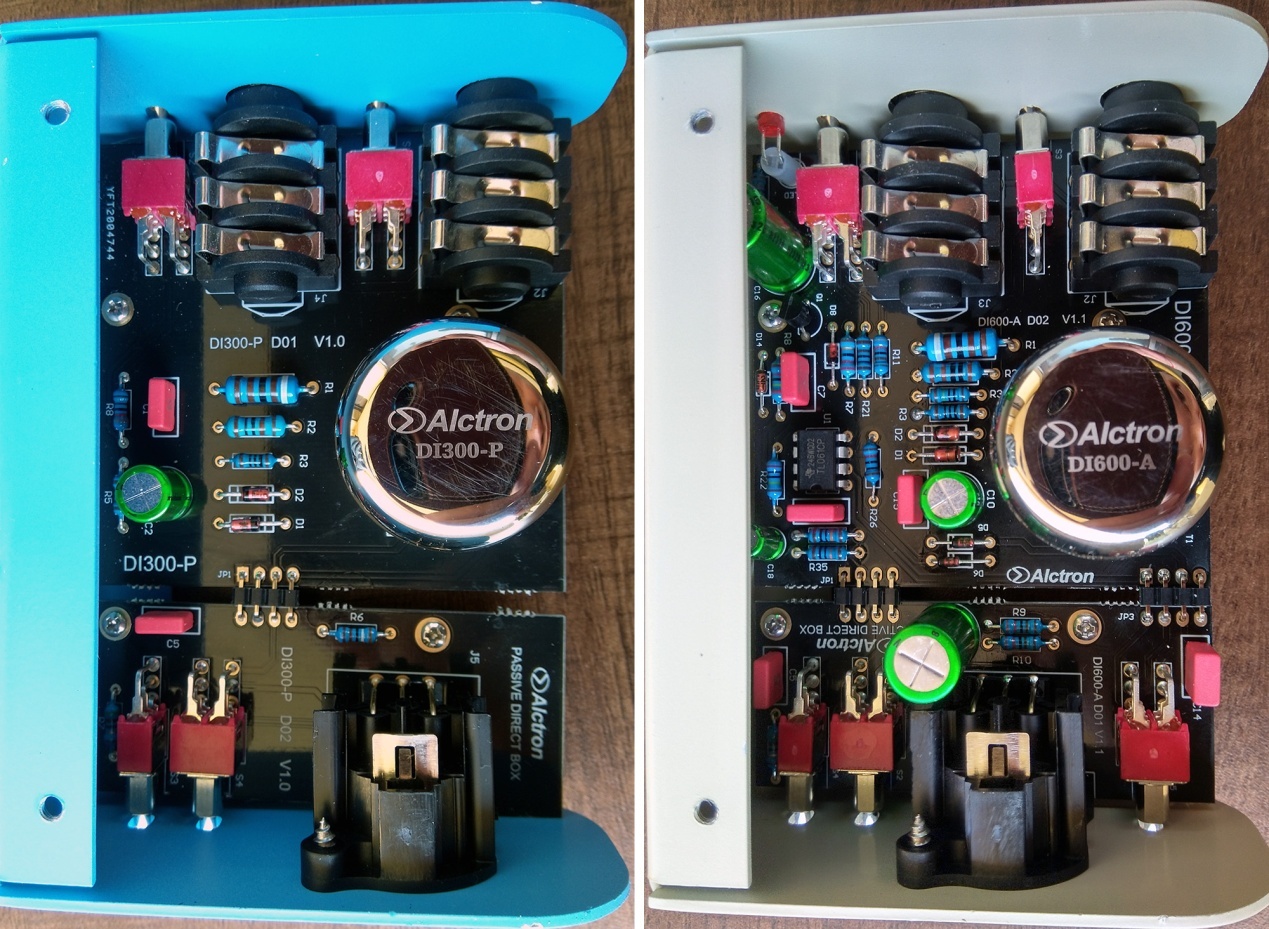
As can be seen, both DI boxes use Alctron transformers. From the appearance, they appear to be toroidal transformers with metal shielding cases. The left image shows the DI300-P, which has a relatively simple circuit primarily relying on transformer coupling (the primary coil connects to the high-impedance instrument signal, while the secondary coil connects to the low-impedance balanced output, generating an alternating magnetic field in the transformer core to produce the corresponding voltage signal).
The DI600-A has a more complex circuit. Its core functionality involves using active electronic components (op amps or FETs) to buffer, impedance match, and balance the output signal. Compared to passive DI boxes, it is better suited for low-level signals (such as electronic keyboards or active pickup basses) and provides a flatter frequency response. Here, a Texas Instruments TL061CP op amp chip is used, as shown in the white circle in the following image.
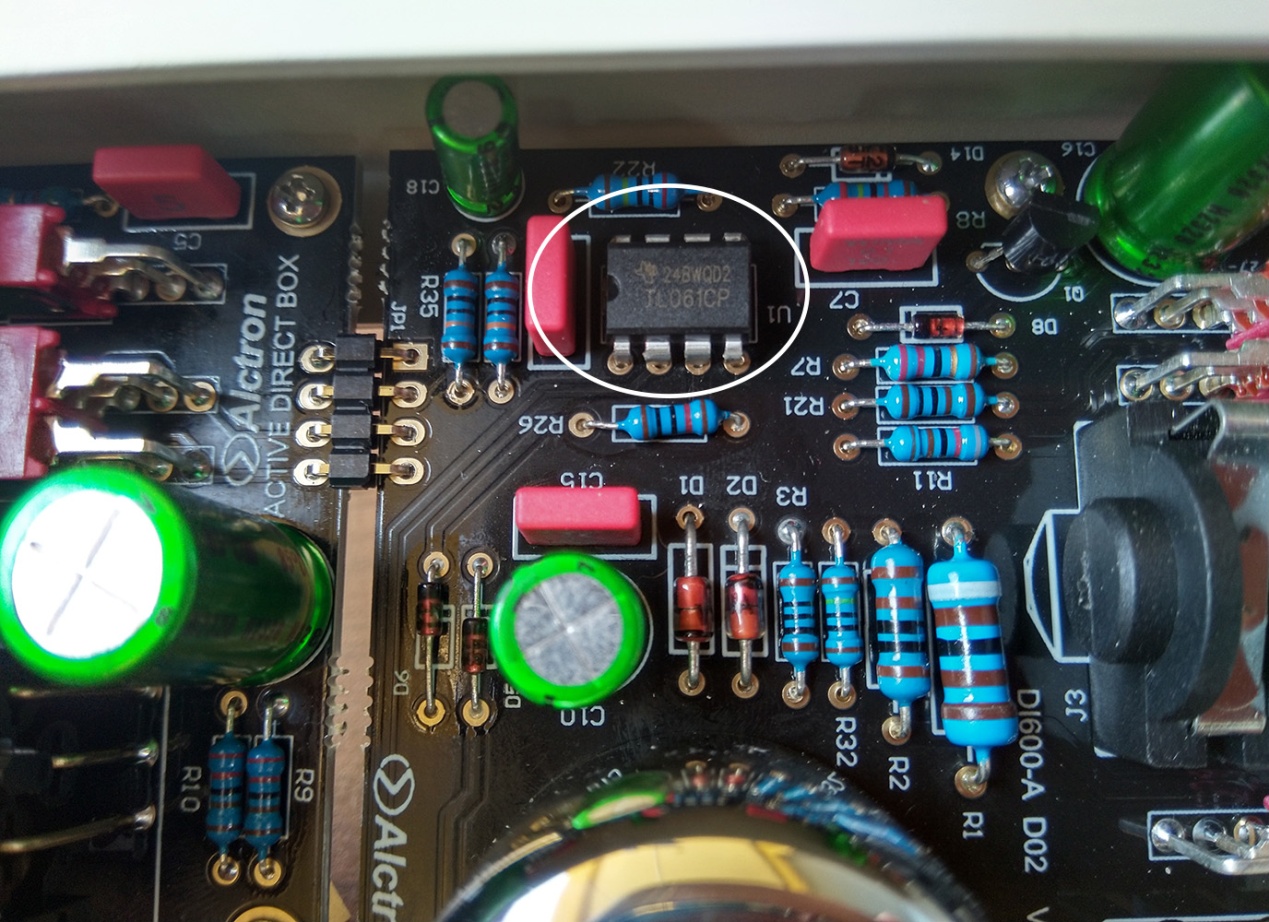
In such active op-amp/FET circuits, the transformer becomes a non-essential component. Since the DI600-A also includes a transformer, its practical uses are as follows:
Signal Isolation and Noise Suppression
Ground Loop Isolation: The transformer transmits signals via magnetic coupling, physically disconnecting the electrical connection between the input and output terminals. This completely eliminates hum (50/60Hz noise) caused by ground loops, providing a more thorough solution than the simple "Ground Lift" switch in purely electronic circuits.
Common-Mode Noise Rejection: In balanced signal transmission, the transformer enhances resistance to electromagnetic interference (such as stage lighting or wireless devices), improving the Common-Mode Rejection Ratio (CMRR) (typically over 60dB).
Impedance Conversion and Signal Adaptation
High/Low Impedance Conversion: Even though the active circuit itself can buffer high-impedance inputs, the transformer further optimizes impedance matching, ensuring perfect compatibility with mixing console microphone inputs (150-600Ω).
Level Attenuation: The transformer passively attenuates the signal (e.g., -15dB), preventing input overload in the active circuit, which is particularly common when handling high-output instruments.
Source of Analog Coloration
Harmonic Coloration: Pure op-amp/FET circuits produce clean tones but may sound "cold." The magnetic saturation characteristics of the custom transformer introduce even-order harmonic distortion, emulating the tonal characteristics of vintage analog equipment (e.g., the "warmth" of the DI600-A).
Frequency Response Fine-Tuning: Custom transformers can optimize low-frequency extension or smooth high-frequency peaks to compensate for frequency response deficiencies in the active circuit.
Circuit Protection
DC Isolation: The transformer blocks DC components (such as DC offsets from faulty equipment), protecting downstream circuits (op-amps/recording devices).
Surge Resistance: Sudden voltage spikes in stage environments (e.g., from faulty plugging/unplugging) can be absorbed by the transformer core, reducing damage risks.
It is worth mentioning that both DI boxes use the top-tier BP capacitors from the Nichicon MUSE series internally. These capacitors feature a green body with black lettering. They are ideal for coupling capacitors, delivering transparent and clear sound with a clean background, good layering, tight lows, and penetrating highs, though the midrange is slightly recessed. Overall, they lean toward a Hi-Fi character, sounding crisp and modern.
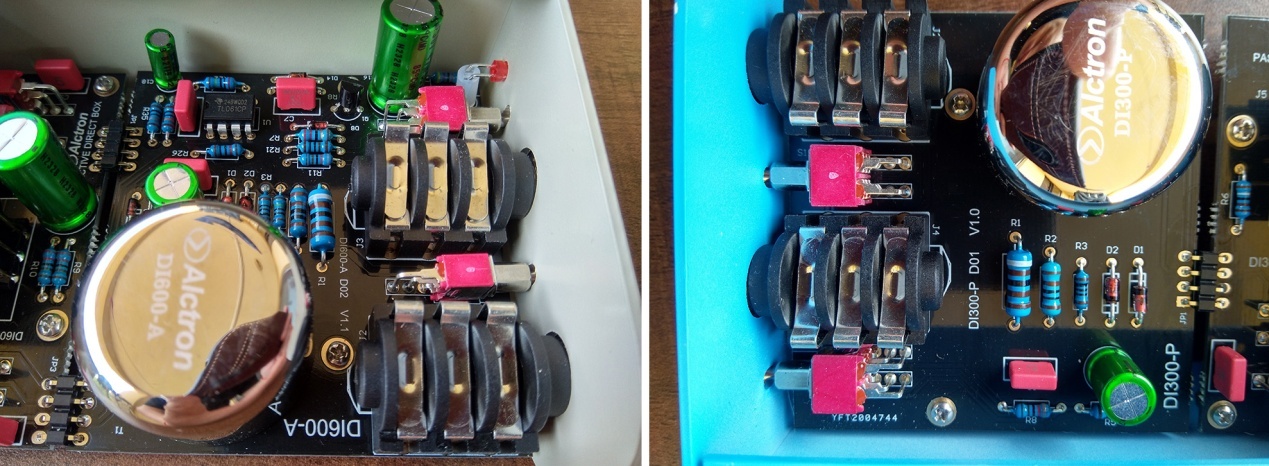
We can intuitively differentiate the differences between active and passive DI boxes through the following table.
Passive vs. Active DI Box | ||
Features | Passive DI box | Active box |
Power requirement | Without power supply | Ask 48V phantom power or battery |
Circuit Type | Transformer Coupling | Active Circuit (Op-Amp/FET) |
Application Scenarios | High-output instruments (passive bass/guitar)
| Low-output instruments (keyboards/active pickups) |
Characteristics of the sound quality | The sound quality is warm and natural, with possible slight high-frequency attenuation. | The frequency response is flatter, and noise control is better. The sound quality is cleaner, possibly with slight electronic coloration. |
Price | Generally low | Generally high |
Impedance Matching. The input impedance of DI boxes is typically high (around 1MΩ), matching the output impedance of electric guitars, basses, and other instruments (usually 10kΩ–1MΩ) to prevent high-frequency signal loss. The output impedance is converted to low (50–600Ω), suitable for mixing consoles or recording interfaces with microphone inputs (XLR connectors, standard impedance: 150–600Ω). Both DI300-P and DI600-A align with these specifications. The technical impact includes: High input impedance reduces signal attenuation and preserves high-frequency details. Low output impedance enables long-distance transmission with reduced noise interference.
Ground Isolation. When connecting multiple devices, ground loops can cause 50/60Hz hum. Both DI boxes feature a Ground Lift switch, which disconnects the signal ground from the device ground and isolates noise via transformer coupling.
Balanced vs. Unbalanced Signal Conversion
‎Instrument outputs are typically unbalanced (TS interface: single core + ground). DI boxes convert them to balanced signals (XLR interface: hot/cold + ground), using differential transmission to suppress common-mode noise. This is achieved via: Transformer isolation (passive DI boxes) or active balanced drive circuits (active DI boxes).
Functionality and Audio Characteristics
Both DI boxes offer advanced features:
Thru/Parallel Out: A 6.35mm TS unbalanced output for connecting amps, recorders, etc.
AMP OUT/INSTRUMENT: Switches between amplified signals and direct instrument signals (selects input sources for THRU and INPUT jacks).
PAD Attenuation Switch: Reduces output signal by 20dB to prevent overload (e.g., for high-output active pickups).
LIFT GND: Disconnects the ground to reduce noise caused by ground loop issues.
Phase Flip: Corrects phase issues to avoid cancellation effects in multi-mic recordings.
ACTIVE/PASSIVE: Switch to select between active and passive modes (DI600-A only).
Key Performance Metrics
Both DI boxes meet professional standards:
Frequency Response: 10Hz–40kHz (professional standard: 10Hz–50kHz).
Total Harmonic Distortion (THD): 0.002% @1kHz (professional standard:<0.1%).
Max Input Level: Supports PAD attenuation (professional standard: +15dBu–+20dBu).
Signal-to-Noise Ratio: 118dB (professional standard: ≥100dB). See test results below.
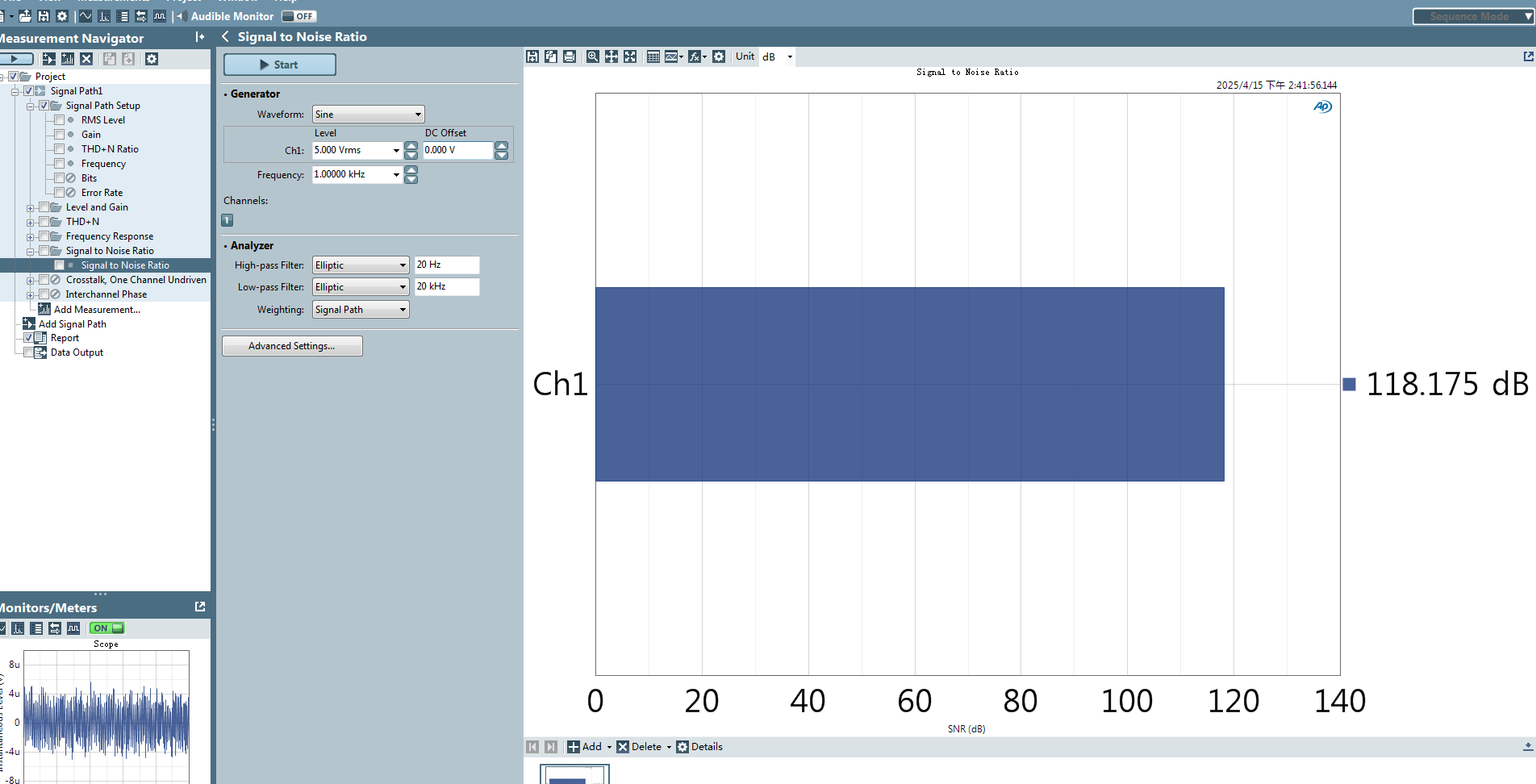
User Experience and Functionality
The following figure shows the performance of the two DI boxes under the same signal source. Specifically, DI300-P is represented by the pink curve; DI600-A by the green curve; and the original signal by the yellow curve. By comparing these three signals, we tested the performance of the DI boxes. It should be noted that all signal sources were the same guitar dry sound, recorded in three separate sessions, which may result in slight differences. Additionally, the spectrogram screenshots are real-time and cannot precisely capture signals at the exact same time point. The following tests review the device’s performance from a user perspective, for reference only.
First, let’s examine the characteristics of impedance matching and signal conversion (see Figures B and C). When connected to high-impedance instruments (passive electric guitars), neither DI box exhibited high-frequency loss or level attenuation in the output signal. As shown in Figure B, DI300-P’s advertised “neutral” tone is accurate, with its output signal closely matching the original. In contrast, the active DI600-A shows overall attenuation in the low, mid-high, and high frequencies, with a relatively balanced frequency response. Figure A illustrates the tonal differences between the two DI boxes.
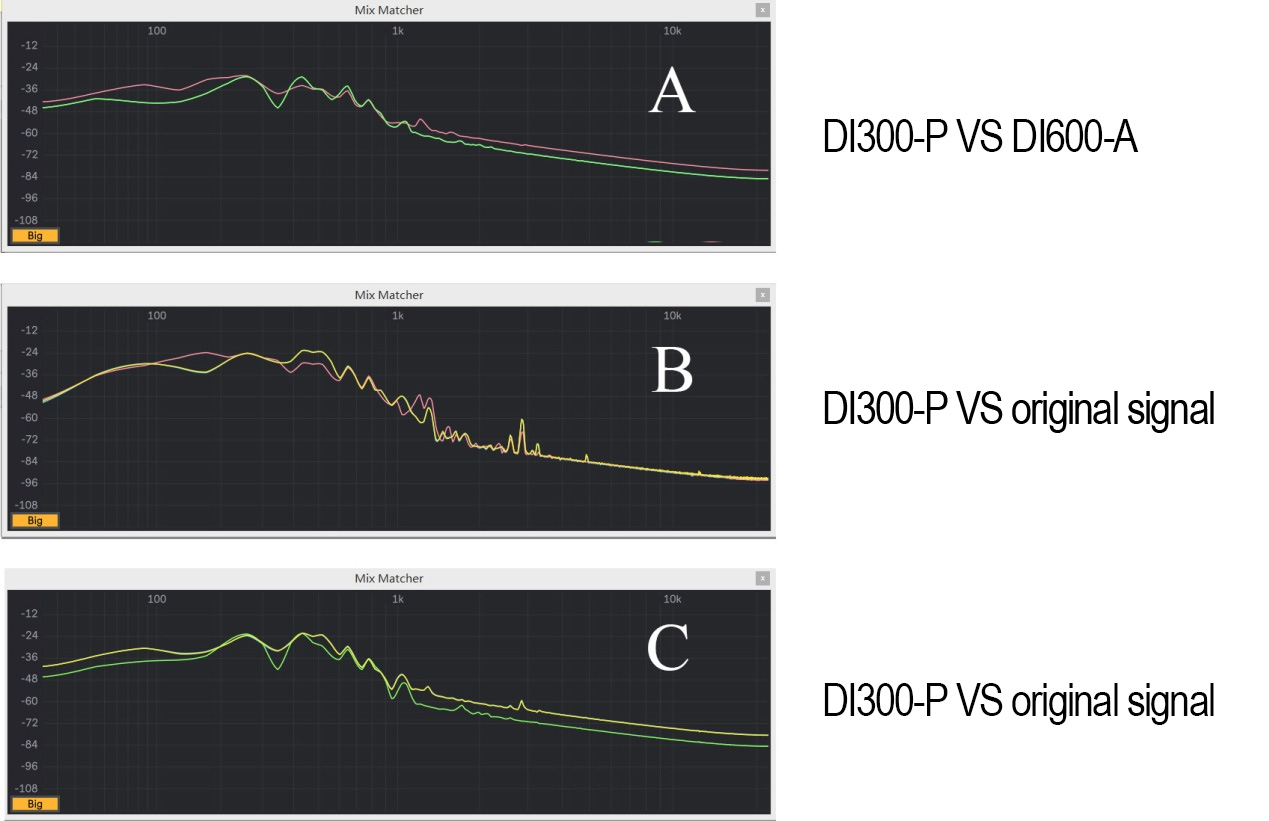
Both DI boxes utilize transformers, and their impact on tone is reflected in harmonic distortion characteristics. The left image below shows the frequency spectrum of the passive DI300-P (pink curve). Its harmonic content is not significantly enhanced, and its passive design does not introduce noticeable natural compression. In contrast, the active DI600-A exhibits pronounced harmonic enhancement, including notable even-order harmonics that contribute to a "warm" tone. This emphasizes the "vintage analog feel" highlighted by DI600-A.
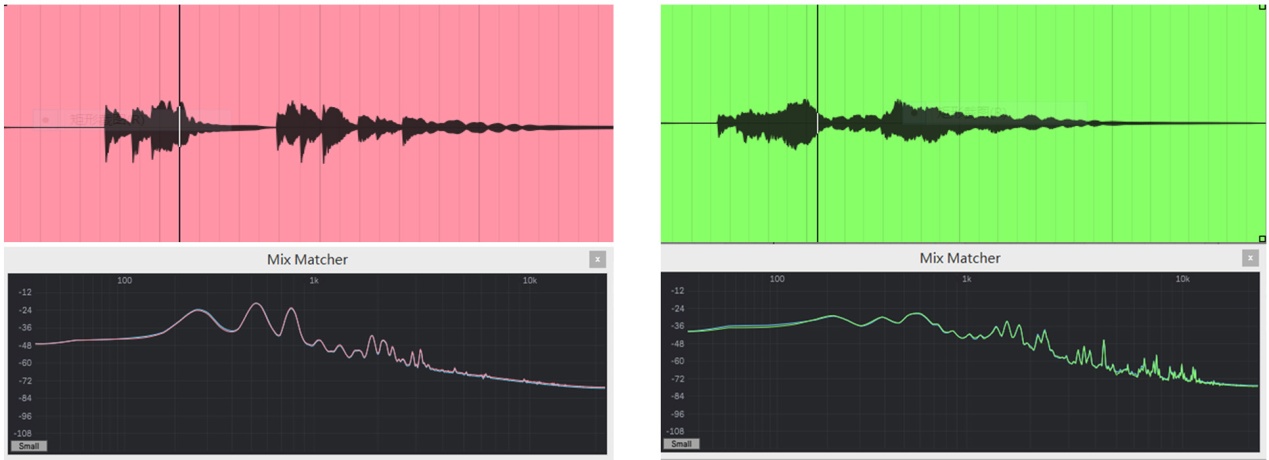
Practical Performance of Ground Isolation. By toggling the Ground Lift switch on/off, I obtained the following comparison. The green curve represents the output signal with ground isolation (Ground Lift on), while the orange-red curve shows the signal without isolation (Ground Lift off). As shown, the grounded output signal exhibits noticeable attenuation around 100Hz, which is the effect of suppressing 50Hz AC hum and its harmonics.
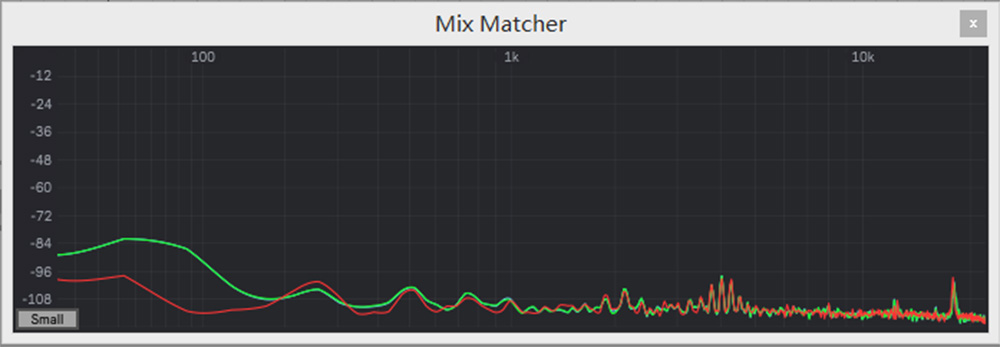
Practicality Test of the 20dB Attenuation Button. To test the PAD attenuation’s effect on distortion and tonal dynamics, I used a high-level signal from a keyboard instrument. The original signal is represented by the green curve, while the 20dB attenuated PAD signal is shown in orange-red. As illustrated below, the PAD attenuation effect is highly noticeable. The original signal (green) and the attenuated signal (orange-red) show significant differences in amplitude, but their waveforms remain largely consistent in the frequency spectrum. This indicates that the PAD attenuation does not introduce additional distortion or alter the tonal dynamics, demonstrating reliable performance.
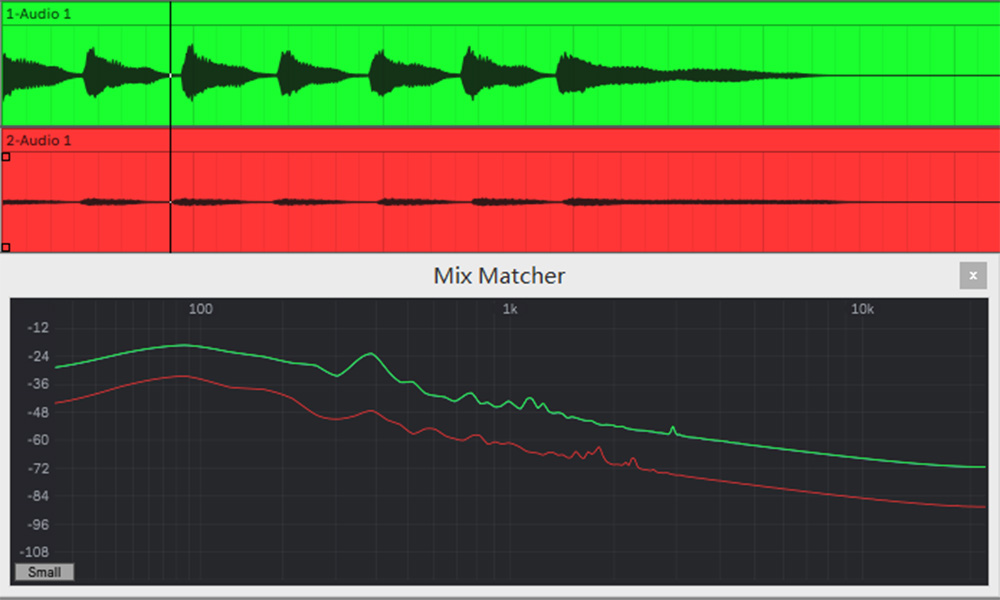
Performance with High-Dynamic Input. To test their handling of large-scale dynamic input, I fed a synthesizer with transient-rich pulse signals into both DI boxes. The green waveform belongs to DI600-A, the orange-red to DI300-P, and the right side shows enlarged transient details. As shown, both DI boxes exhibit highly similar waveforms, with near-perfect transient responses—no clipping or distortion occurs. This demonstrates their capability to handle high-dynamic input effortlessly.
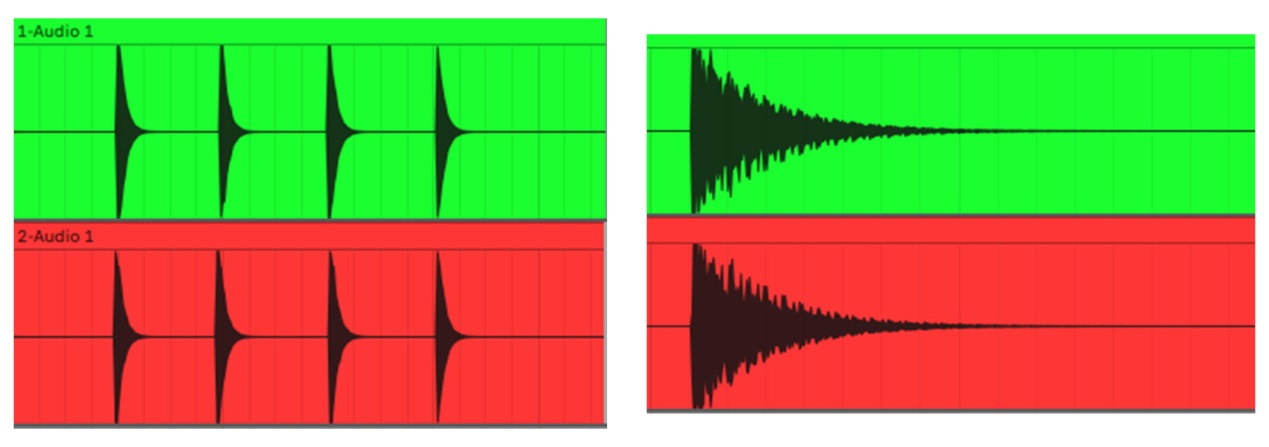
Ease of Use. Both DI300-P and DI600-A share excellent build quality. Their switches offer a satisfying tactile feel, and the interface layout is logical and easy to plug/unplug. The control panels are organized according to signal flow, minimizing confusion during operation. Users with prior experience in audio equipment or basic audio knowledge can quickly adapt. The控件 intervals on the panels are well-designed to prevent accidental mistouches.
Pricing and Value for Money
DI300-P (Retail: ¥598):
‎Ideal for budget-conscious users seeking stability. Its passive design requires no power, suitable for high-output instruments (e.g., passive basses).DI600-A (Retail: ¥728): The ¥130 premium over the passive model adds mode-switching functionality and active amplification, targeting professionals who need flexibility for diverse sources (e.g., low-level keyboard signals). It offers higher value for multi-scenario use.
Market Edge and Technical Differentiation, DI600-A’s active/passive switching functionality stands out in its price range, making it particularly suited for mixed-instrument live environments.
Sound Performance, DI300-P’s “uncolored” characteristic meets studios’ demands for neutral tones. DI600-A’s active mode delivers a vintage analog-like warmth, appealing to users seeking retro vibes.
Purchase RecommendationsDI300-P Best For: High-output instruments (e.g., passive pickup electric guitars) without tone adjustment needs. Live performances prioritizing portability and no external power requirements. Budget-limited users seeking basic signal conversion. Beginners or cost-sensitive scenarios where reliability outweighs advanced features.DI600-A Best For: Flexible mode switching (e.g., studios adapting to various instruments). Low-level signal processing (e.g., keyboards, electronic drums) requiring active gain compensation. Warmth-seeking users or multi-device compatibility (e.g., mixing consoles + effects). Professionals needing tone shaping or complex signal handling. Its active mode ensures future-proof adaptability.
Conclusion
Both DI300-P and DI600-A demonstrate strong technical execution. DI300-P excels in stability and affordability, while DI600-A shines in versatility and tonal customization. Choose based on budget, use case, and tone preferences. For long-term flexibility, DI600-A’s active mode justifies its premium.
Potential Limitations: DI300-P’s passive design may lack detail with low-level signals; pair with a high-gain preamp if needed. DI600-A requires attention to power stability (e.g., battery life or phantom power compatibility).